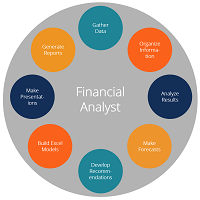- How may I help you?
- 8233970000
- 9829016449
- info@ipsedu.in
Decoding the Financial Analyst Profile
Who is a Financial Analyst?
- Financial analysts examine financial data and use their findings to help companies make business decisions. Often, their analysis is meant to inform the investing decisions of companies. More specifically, financial analysts research macroeconomic and microeconomic conditions along with company fundamentals to make predictions about businesses, sectors, and industries. They also often recommend a course of action, such as buying or selling a company's stock based upon its overall performance and outlook.

- An analyst must be aware of current developments in the field in which they specialize, as well as in preparing financial models to predict future economic conditions for any number of variables.
- Not all financial analysts analyze the stock or bond markets or help their employers make investments. Companies may also hire an analyst to use numerical data to pinpoint the efficacy of various marketing techniques relative to cost. Businesses that utilize the franchise model often have financial analysts who are responsible for tracking individual franchises or groups of franchises within a geographic region. The analysts determine where the strengths and weaknesses lie and make profit and loss forecasts.
- Analysts, therefore, have many duties and responsibilities, depending on the organization they work for, the industry they are in, and their seniority. Below is a list of the most common things they do:
- Gather Information and Data
- The work of a financial analyst starts with gathering data and information about whatever they need to analyze. Examples include historical financial reports, accounting data from the general ledger, stock price information, statistics and macroeconomic data, industry research, and just about any other type of quantitative data. The information will be gathered from sources such as the company’s internal databases, third-party providers such as Bloomberg or Capital IQ, and government agencies.

- Organize Data
- Once the data is gathered it’s typically entered into Excel or some other type of database. Once the input is done, the next task is to organize it, clean it up, and get it into a format which makes sense and is informative in nature. This typically means sorting the numbers by data, or by category, adding formulas and functions to make sure it’s dynamic, and using consistent formatting styles so that it’s easy to read and understand.
- Analyze Financial Results
- With the data all cleaned up and organized in Excel, it’s time for the financial analyst to start analyzing past information and historical results. This typically includes looking at ratios and metrics like gross margin, net margin, fixed vs. variable costs, year-over-year (YoY) growth rates, return on equity (ROE), return on assets (ROA), debt/equity ratio, earnings per share (EPS), and many others. The analyst will look for trends and benchmark the performance against other companies in the same industry.
- Making Forecasts and Projections
- Now that historical information has been analyzed, it’s time to make projections and forecasts about how the company will perform in the future. This is an amalgamation of both art and science resulting in prediction of how a company will perform, including assumptions and even leaps of faith that have to be made. Common forecasting methods include regression analysis, year-over-year growth rates, as well as bottom-up and top-down approaches.
- Develop Recommendations
- A good financial analyst is not only good with numbers but actually generates insights and recommendations on how to improve the operations of a business. Examples of helpful recommendations and insights include ways to cut costs, opportunities to grow revenue, ways to increase market share, operational efficiencies, customer satisfaction, and much more. This is what truly separates a world-class financial analyst from the rest. These recommendations will be presented to the CEO, the CFO, other executives, and/or the board of directors.
- Build Excel Models
- For analysts working in investment banking, equity research, corporate development, financial planning & analysis (FP&A), and other areas of corporate finance, financial modelling will be a big part of the job. These models typically start by linking financial statements and then layering on more advanced types of financial models such as discounted cash flow analysis (DCF models), internal planning models, and more arcane models such as LBO models and M&A models.
- So If we go for a ‘Birds-Eye-View’ of the Job description of a Financial Analyst, it can be laid down as:
- Perform financial forecasting, reporting, and operational metrics tracking
- Analyze financial data and create financial models for decision support
- Report on financial performance and prepare for regular leadership reviews
- Analyze past results, perform variance analysis, identify trends, and make recommendations for improvements
- Work closely with the accounting team to ensure accurate financial reporting
- Evaluate financial performance by comparing and analyzing actual results with plans and forecasts
- Guide the cost analysis process by establishing and enforcing policies and procedures
- Provide analysis of trends and forecasts and recommend actions for optimization
- Recommend actions by analyzing and interpreting data and making comparative analyses; study proposed changes in methods and materials
- Identify and drive process improvements, including the creation of standard and ad-hoc reports, tools, and Excel dashboards
- Increase productivity by developing automated reporting/forecasting tools
- Perform market research, data mining, business intelligence, and valuation comps
- Maintain a strong financial analysis foundation creating forecasts and models
- Proficiency with Microsoft Excel is mentioned in virtually any financial analyst job description; familiarity with data query/data management tools is extremely helpful (Access, SQL, Business Objects etc.)

Technical/Hard Skills that you need to Project
- Hands-on business finance or other relevant experience or expertise – through projects, OJTs or Internships
- High proficiency in financial modelling techniques
- Strong fluency with Excel formulas and functions
- Strong analytical and data gathering skills
- Good business acumen
- MBA in Finance as a Specialization
- Knowledge of Statistics
- Personality Traits/Soft Skills that you need to Project
- Ability to streamline functions and passion to learn and grow
- Strong interpersonal skills, including written and oral communication skills
- Comfortable in dealing with ambiguity and the ability to work independently as well as in a team.
- Excellent communication and presentation skills; being comfortable in interacting with senior/executive-level management
- Analytical bent of mind
- Orientation towards Research and Development
- Going into the details
- An eye for information and keeping in tune with the business world
- Companies which you can research to further understand the profile of Financial Analyst
- Amazon, S&P Global, Galleon Consultants, Mastercard, American Express, Philips, Unisys, CRISIL Limited, Xoriant, Accenture, Oracle India Pvt. Ltd., D.E. Shaw Group, FIS Global, Gartner India Research and Advisory Services, Parexel International (India) Pvt. Ltd., MCube Advisors India Pvt. Ltd, PayPal, Motorola Solutions, Fiddich Consulting and many more…there are approximately more than 33184 openings in India as of now when this article is going to be published.
profesionalus butų remontas ir vidaus apdailos darbai Vilniuje https://bustovizija.net





